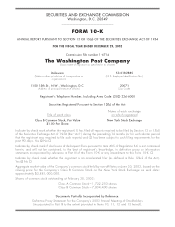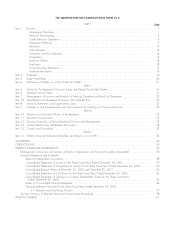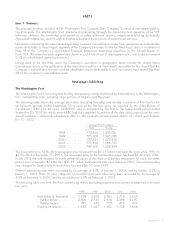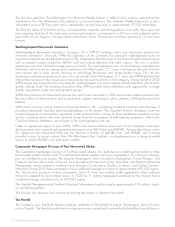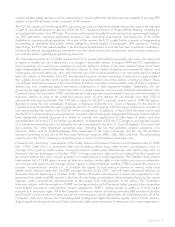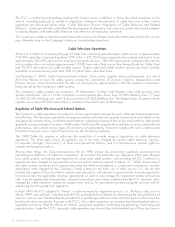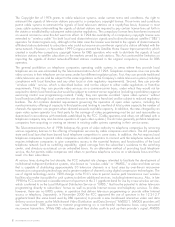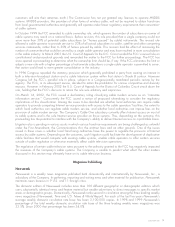Washington Post 2002 Annual Report Download - page 7
Download and view the complete annual report
Please find page 7 of the 2002 Washington Post annual report below. You can navigate through the pages in the report by either clicking on the pages listed below, or by using the keyword search tool below to find specific information within the annual report.unclear whether cable operators will be responsible for ensuring that their set-top boxes are capable of passing DTV
signals in their full definition to the consumer’s DTV receiver.
The FCC has a policy of reviewing its DTV rules every two years to determine whether those rules need to be adjusted
in light of new developments. In January 2003 the FCC released a Notice of Proposed Rule Making, initiating the
second periodic review of its DTV rules. This review will examine broadly the rules and policies governing broadcast-
ers’ DTV operations, including interference protection rules, operating requirements, and extensions of the 2006
deadline for ceasing analog operations. As a part of this review, the FCC sought further comment in long-pending
proceedings to determine what public interest obligations should apply to broadcasters’ DTV operations. Among
other things, the FCC has asked whether it should require broadcasters to provide free time to political candidates,
increase the amount of programming intended to meet the needs of minorities and women, and increase communica-
tion with the public regarding programming decisions.
The Telecommunications Act of 1996 requires the FCC to review its broadcast ownership rules every two years and
to repeal or modify any rule it determines is no longer in the public interest. In August 1999 the FCC amended its
local ownership rule to permit one company to own two television stations in the same market if there are at least
eight independently owned full-power television stations in that market (including non-commercial stations and
counting the co-owned stations as one), and if at least one of the co-owned stations is not among the top four ranked
television stations in that market. The FCC also decided to permit common ownership of stations in a single market if
their signals do not overlap, and to permit common ownership where one of the stations is failing or unbuilt. These
rule changes permitted increases in the concentration of station ownership in local markets, and all of the Company’s
stations are now competing against two-station combinations in their respective markets. Separately, the rule
governing the aggregate number of television stations a single company can own was relaxed by amendments to the
Communications Act enacted in 1996, and broadcast companies are now permitted to own an unlimited number of
television stations as long as the combined service areas of such stations do not include more than 35% of
nationwide television households. The 35% limit is subject to the FCC’s periodic review, and in 1999 the agency
decided to leave the rule unchanged. However, in February 2002 the U.S. Court of Appeals for the District of
Columbia Circuit found that the reasons given by the FCC for retaining the 35% limit were insufficient as a matter of
law and remanded the matter to the FCC for further consideration. In addition, in April 2002 the same court found
that the FCC’s rule permitting co-owned stations in markets with at least eight independent full-power stations had not
been adequately justified because of a failure to consider the significance of other types of media and also
remanded that rule to the FCC for further consideration. In September 2002 the FCC began a new periodic review
of its broadcast ownership rules, including the two rules remanded to it by the U.S. Court of Appeals. This review will
also examine four other broadcast ownership rules, including the rule that prohibits common ownership of a
television station and an English-language daily newspaper in the same community and the rule that prohibits
common ownership of any two of the four major television networks (ABC, CBS, NBC and Fox). This proceeding
could result in the FCC’s relaxing or eliminating one or more of its broadcast ownership rules.
Pursuant to the ‘‘must-carry’’ requirements of the Cable Television Consumer Protection and Competition Act of 1992
(the ‘‘1992 Cable Act’’), a commercial television broadcast station may, under certain circumstances, insist on
carriage of its signal on cable systems serving the station’s market area. Alternatively, such stations may elect, at
three-year intervals that began in October 1993, to forego must-carry rights and insist instead that their signals not
be carried without their prior consent pursuant to a retransmission consent agreement. The Satellite Home Viewer
Improvement Act of 1999 gave commercial television stations similar rights to elect either must-carry or retransmis-
sion consent with respect to the carriage of their signals on direct broadcast satellite (‘‘DBS’’) systems that choose to
provide ‘‘local-into-local’’ service (i.e., to distribute the signals of local television stations to viewers in the local
market area). Stations made their first DBS carriage election in July 2001 and will make subsequent elections at
three-year intervals beginning in October 2005. Stations that elect retransmission consent may negotiate for com-
pensation from cable and DBS systems in the form of such things as mandatory advertising purchases by the system
operator, station promotional announcements on the system, and cash payments to the station. The Company’s
television stations, with the exception of WJXT, are being carried on all of the major cable systems in their respective
local markets pursuant to retransmission consent agreements. WJXT is being carried on cable in its local market
pursuant to its must-carry rights. All of the Company’s television stations are being carried by DBS providers EchoStar
and DirecTV on a local-into-local basis pursuant to retransmission consent agreements. As noted previously, all of the
Company’s television stations are transmitting both analog and digital broadcast signals; most of those stations’
digital signals are being carried on at least some local cable systems pursuant to retransmission consent agreements.
2002 FORM 10-K 5

